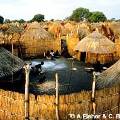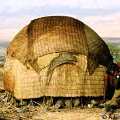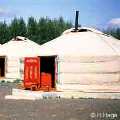
Reed Houses of Uros Tribe – Titicaca Lake, Peru
Lake Titicaca is nearly 400 meters above sea level. About 2,000 Uros people live on about 50 artificial reed Islands made of floating reeds in the lake. They make a living by fishing and tourism. The boats and houses are all made of reed. They have to pile fresh reed over them every several months as the old reed decays.
Full Post

Anuak Tribe Village – Omo Valley, Ethiopia
The Anuak people live in the northwest part of Omo valley. They build their houses one per family and gather in the village. In the center of the village, they grind corn into flour to cook rice porridge.
Full Post

Dome-shaped House of the Afar Tribe – Eritrea
Afar people are nomad living in Great Rift Valley. Their houses are called Bulla, which is a transferable compact dome shaped structure. It is built of straw, which is easy to carry.
Full Post

Sun Dried Brick House of Berber Tribe – Merzouga, Sahara Desert, Morocco
In the southern part of Morocco, the houses are made of the bricks. Water is mixed with clay soil and placed into a mold to dry under the Sun. The same clay is used to paste bricks one by one and then, paste the clay over the bricks to build the house. The bricks can keep the room temperature at comfortable level, even as the outside temperatures change drastically during a day.
Full Post

House of Lafu Tribe – Norhern Region, Thailand
In the Village of Lahu Tribe, nearly 5,000 people live in houses on the steep land 1,000 meters above sea level. The floor of the house is 2 meters high and under the floor, they keep cow, pigs and chicken. The houses are built with wood panels crossing each other.
Full Post

Houses on the Water – Sabah, Malaysia
The fishermen of Saba in the Borneo Island live in a village on the water. They use the timber of mangrove tree which has the durability against the sea water to build the water structures. The houses are officially issued addresses and family registrations.
Full Post

Tree House of Bagobo Tribe – Mindanao Island, Philippines
The people in the south of Philippines used to live in the tree houses. From the tree houses, they could spot the enemies and protect from poisonous snakes and wild animals. They also enjoyed the cooler and drier air. The houses had to be rebuild as the trees grew. These tree houses are now used for meetings and resting.
Full Post

Complex Houses of a Hakka Family – Fujian, China
In the dry Fujian area, the houses are built with hard solid soil walls. Built about 300 years ago, The Hakka family built the town houses surrounded by the hard walls to protect from the outsiders. The houses are 4-storied and hundreds of people live together under the same roof. One townhouse belongs to the whole family with the same last name. Hakka family members with a different last name are not allowed to live there.
Full Post

Ger – Gobi Desert, Mongolia
Ger is the Mongolian transferable nomad house. They move the house when their domestic animals have eaten the grass in that area. The main 2 poles in the center support the house with the framework, which is covered with the white cloth filled with wool and hair of the domestic animals. In the center, the ceiling can be opened for the smoke coming from the stove. During the severe winter, a double cover is placed on the ceiling.
Full Post

Ondol – Suwon, Korea
Ondol is the traditional under floor heating system which has been used in Korean peninsula where the winter is very severe. The heat from the stove in the kitchen goes through the pathway under the floor. They use the firewood or straw for the stove. The entrance of the house is made smaller to prevent cold air coming into the house. They sleep on the warm floor with the mat and they do not need to wear room shoes. In the modern Korean house, Ondol is still used for hot water.